
Сборник трудов конференции СПбГАСУ ч
.2.pdf
Раздел 4. Лабораторные и полевые исследования грунтов и фундаментных конструкций…
tions. In general, the concentrated pile arrangement case can result in total and differential settlements lower by about 30– 40% compared with the uniform pile arrangement case. Based on the results, the authors proposed the conclusions and the following guidelines for optimum design:
(a)Increasing the raft thickness considerably reduces the total and differential settlements. There is an upper limit for raft thickness that minimizes the differential settlement. However, this option does not satisfy economical design constraints and should be carefully considered.
(b)Increasing the pile length considerably reduces the total and differential settlements. For an economical design, it is recommended that the pile length should only be increased at the positions for the allowable settlement.
(c)Increasing number of piles reduces the total and differential settlements but the efficiency is not high. This option also does not satisfy the economical design and should be carefully considered.
References
1.Fleming, W. G. K., Weltman, A. J., Randolph, M. F. and Elson, W. K. (1992). Piling engineering. 2nd edn. New York: Wiley.
2.Horikoshi, K. and Randolph, M.F. (1996). “Centrifuge modelling of piled raft foundations on clay.” Geotechnique, Vol. 46, No. 4, pp. 741-752.
3.Horikoshi, K. and Randolph, M.F. (1998). “A Contribution to Optimal Design of Piled Rafts.” Geotechnique, Vol. 48, No. 3, pp. 301-317.
4.Katzenbach, R., Bachmann, G., Boled-Mekasha, G. and Ramm, H. (2005). “Combined pile raft foundations (CPRF): An appropriate solution for the foundations of high-rise buildings.” Slovak journal of civil engineering, pp.19-29.
5.Kim, K.N., Lee, S.H., Kim, K.S., Chung, C.K., Kim, M.M. and Lee, H.S. (2001). “Optimal pile arrangement for minimizing differential settlements in piled raft foundations.” Computers and Geotechnics, Vol.28, pp. 235-253.
6.Nguyen DDC, Jo SB and Kim DS (2013). Design method of piled-raft foundations under vertical load considering interaction effects. Computers and Geotechnics; 47(3): 16-27.
7.Nguyen DDC, Kim DS, Jo SB (2013). Settlement of piled rafts with different pile arrangement schemes via centrifuge tests. ASCE Journal of Geotechnical and Geoenvironmental Engineering; 139(10), 1-9.
8.Nguyen D.D.C, Kim D.S., Jo S.B (2014). Parametric Study for Optimal Design of Large Piled Raft Foundations on Sand. Computers and Geotechnics. Vol. 55, pp. 14-26.
9.Poulos, H.G. (2001a). “Piled Raft Foundations: Design and Applications.” Geotechnique, Vol. 51, No. 2, pp. 95-113.
10.Randolph, M.F. (1994). “Design Methods for Pile Groups and Piled Rafts”. S.O.A Report, 13 ICSMFE, New Delhi, 5: 61-82.
231

Современные геотехнологии в строительстве и их научно-техническое сопровождение
Malinowska E., Bursa B.,and Szymański A.
(Laboratory of Water Centre, Faculty of Civil and Environmental Engineering, Warsaw University of Life Sciences, Poland)
THE MODIFIED ROWE CELL SET FOR OBTAINING CONSOLIDATION AND FLOW CHARACTERISTICS IN SOFT ORGANIC SOILS
ABSTRACT
In this paper the Modified Rowe Cell Set is presented. The MRCS is adapted to measure, at the same time, the consolidation and permeability parameters.
Sometimes it is necessary to carry out consolidation and permeability tests using the technique other than conventional oedometer test for project and construction for reclamation or improvement engineering tasks.
In response to this need, some series on Modified Rowe Cell Set, consolidation and permeability tests were performed, on soft organic subsoil taken Campus SGGW test site.
The Soil-Water Characteristics are important in soft organic soil compressibility. The rate of deformation depends on pore pressure dissipation. In anisotropic organic structure the vertical and horizontal direction of consolidation should be considered. That is why, the modification had been done. In this method, it is able to model in-situ flow rate in fully saturated and unsaturated conditions. The settlement, pore water pressure, and back pressure in both directions is currently checked and analysed during the test.
The results obtained in MRCS confirm the non-linear strain and flow characteristics in soft organic soils.
Key words: MRCS, non-linear water flow characteristic, consolidation process, organic
soils.
INTRODUCTION
The soft organic soils are very problematic for investments, because of their specific properties such as high vertical and horizontal deformations which occur during and after the construction period, low initial shear strength which can causes difficulties to achieve the embankment stability, high initial permeability which changes drastically during the loading. The most common and relatively cheap method of soil improvement is consolidation caused by applied loading by stages.
The consolidation process depends on distribution of water pore pressure which is connected to permeability [4, 5,6]. To design and prognosis engineering constructions behaviour on soft organic soils the analysis of value and course of subsoil deformations and water pore pressure should be known [3, 4].
In loaded soft subsoil the significant consolidation process is observed. The consolidation process in this type of soil consists of two stages: primary settlement (immediate and consolidation) and secondary (and tertiary) settlement (creep) [1, 9]. Primary settlement is the result of immediate undrained elastic deformation of the subsoil under an applied load. However, secondary and tertiary settlement is
232

Раздел 4. Лабораторные и полевые исследования грунтов и фундаментных конструкций…
the consequence of creep of material under the effective stress. It depends significantly on time and rheological properties of soil. Moreover, the rate of strain can increase and decrease during the creep phase as well as depends on the level of deviatory stress [9].
During laboratory consolidation tests, it is very important to point the time and value of primary settlement and to indicate the beginning of secondary and tertiary settlement. Most of the analyses skip this task.
To obtain the water flow characteristics in soft organic subsoil during laboratory tests it is necessary to model the in-situ conditions with consideration of very high water content, fully saturation, very high deformations both in vertical and horizontal direction, unpredictable effective stress and pore pressure range. One of the very precise method for obtaining flow characteristics is flow-pump technique [4], but it does not allow to perform the test in different flow and consolidation drainage directions.
THE MODIFIED ROWE CELL SET
A lot of different methods, direct and indirect, can be used to measure the water flow in saturated soils in the laboratory tests. However, it is very important to choose a proper method because of the reliability of the test results, repeatability and reproducibility of the test results, the reconstruction of reflection in-situ conditions, difficulties and costs of the tests. In order to take into consideration these factors it is recommended to use direct laboratory methods to eliminate additional calculation errors [7].
The Rowe Cell is used to obtain consolidation or permeability parameters [2]. Using the Rowe Cell it is possible to control hydraulic load, vertical and horizontal drainage and to measure vertical deformations and pore water pressure during consolidation test.
The Modified Rowe Cell Set is used to obtain consolidation and permeability parameters at the same time. Using the Modified Rowe Cell Set it is possible to control pneumatic load, vertical and horizontal drainage and to measure vertical deformations and pore water pressure during the consolidation and permeability test. Also it is able to model different conditions of soil sample saturation (Fig. 1).
The MRCS is provided by: vertical stress controller (ADC)-3MPa, back pressure/volume controller (HDC)- 3MPa/250mL, pore water pressure sensor1MPa, vertical settlement sensor (S), data logger (R), Rowe Cell, software for data control and data collection – csRowe.
In the MRCS, the tested sample is loaded pneumatic by air pressure (ADC). The Rowe Cell can be connected to back pressure unit, working in vertical (BPv), or horizontal (BPh) direction. The back (BP) pressure supports the pressure that is needed to make the effective stress. Also the direction of the drainage is simulated, at that time. Drainage of the sample is controlled all the time, and the pore pressure
233
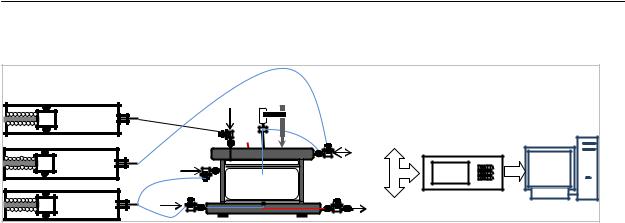
Современные геотехнологии в строительстве и их научно-техническое сопровождение
and volume change is measured automatically. Eight different types of drainage and load conditions can be applied in Rowe Cell Set.
ADC |
L |
S |
|
|
|
|
CU+S |
||
|
A |
BP |
R |
|
HDC |
BP(h) |
|
||
|
|
|||
|
|
|
HDC |
BP(V) |
PWP |
|
Fig. 1. – The Modified Rowe Cell Set: ADCair device controller, HDChydraulic device controller, BP(v) – back pressure with vertical drainage, BP(h) – back pressure with horizontal drainage, L- load, A – air, S- settlement, PWP – pore water pressure, R- recorder, CU+S – computer unit with software
In the conventional Rowe Cell Set there are two device controllers, that stop the set to apply two kinds of tests at the same time. The Modified Rowe Cell Set is able to conduct permeability tests in different strain conditions. It is possible to set precise effective strain by using air device controller (ADC) and back pressure unit (BP), or just the vertical load, by ADC. Also, it is possible to hold exact value of stress and apply vertical or horizontal permeability test. And, repeat it in different stress conditions, to obtain the stress-flow characteristics, and also stress-strain characteristics at the same time.
In the MRCS it is possible to apply free or equal loading, to model in-situ conditions of embankment or fundamental stress. And also, it is possible to conduct CRS or IL tests.
All these possibilities can be applied to MRCS and read, and analyzed by Rowe Software ClispStudio, VJT-csRowe.
OBTAINING CONSOLIDATION AND FLOW CHARACTERISTICS IN SOFT ORGANIC SOILS USING MRCS
To obtain the test all devices have to be connected. The pneumatic and hydraulic pressure controllers need to be connected to a PC serial port and to Rowe Cell (Fig.2).
To start test it is necessary to choose the type of test, Rowe Cell test or permeability test that contains consolidation and permeability. It needs to create test name, client name, job file, and borehole and sample name. As soon as the test is created, a wizard will open up for the configurations, where is possible to complete the hardware setup and specimen details. In each test another stages can be chosen from swelling, saturation, consolidation and permeability. When the test is stopped, the red letters displays (Fig.3).
The swelling test is optional. This stage is controlled automatically by csRowe by applying a vertical stress to prevent the swelling.
234
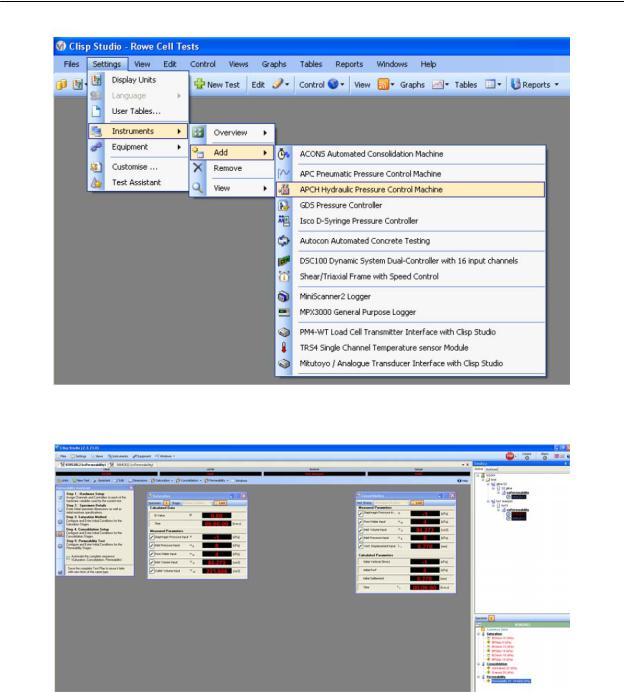
Раздел 4. Лабораторные и полевые исследования грунтов и фундаментных конструкций…
Fig.2. – The connection of test devices
Fig. 3. – The MRCS test application
The csRowe software provides two method of saturation, Ramp or a step method. In the step method, the cell and back pressure are increased in steps until the desired B-value is achieved. In the Ramp method, that had been chosen, the cell and back pressure are ramped and the b-check is carried out at regular intervals to see whether the required b-value has been reached. The saturation stage is end when the wanted B-value is reached. The B-value is calculated by raising the cell pressure by the required amount and the PWP is stabilized (Fig. 4).
The consolidation stage consists of a undrained loading followed by a drained stage.
235
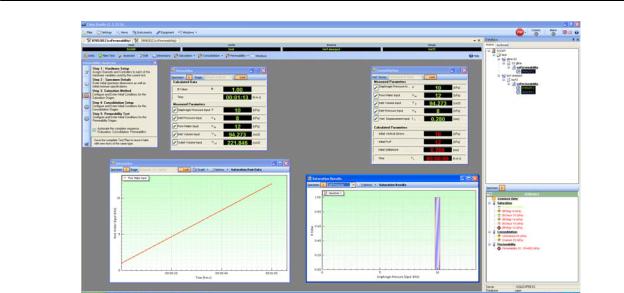
Современные геотехнологии в строительстве и их научно-техническое сопровождение
Fig. 4. – The Ramp saturation method
It is possible to apply for free or equal stress loading, during the consolidation process.
For every load increment (increasing or decreasing) the specimen is subject to an undrained and a drained phase. During the undrained stage, vertical stress is applied to the specimen with the drainage valve closed (BP) and consequently the increase in pore water pressure is monitored. This schedule is stopped when the PWP becomes stable. During the drained stage, the drainage valve (BP) is opened and kept the same, only the loading value (L) is changing. The vertical stress is maintained until the PWP dissipation reaches the predefined value 100%. The PWP, volume change and the settlement are monitored and automatically carried out during this stage (Fig.5).
After consolidation stage, it is possible with MRCS to immediately start the permeability tests in specific consolidation conditions. The vertical and horizontal permeability tests are able to done in one or two ways (up and down for vertical and outside or inside for horizontal).
In the permeability stage, the hydraulic gradient is applied, and the flow velocity can be calculated. The ClispStudio Program registers the volume change in both hydraulic device controllers. For vertical permeability the back pressure at the bottom (BPv) should be bigger than the one on the top (BP), because of the gravitation pressure. For the horizontal permeability, the back pressure at the site (BPh) should be bigger than the one on the top (BP), for the income flow, and smaller for the outcome flow (Fig.6).
In MRCS it is possible to add as many permeability stages, as is necessary. The permeability stage is finished when the volume in and volume out is parallel (Fig. 7). Then the next stage starts automatically. And the permeability test can run by itself for a few days, the only problem is the quite small hydraulic device volume (250mL). So, it is necessary to check it every time.
236
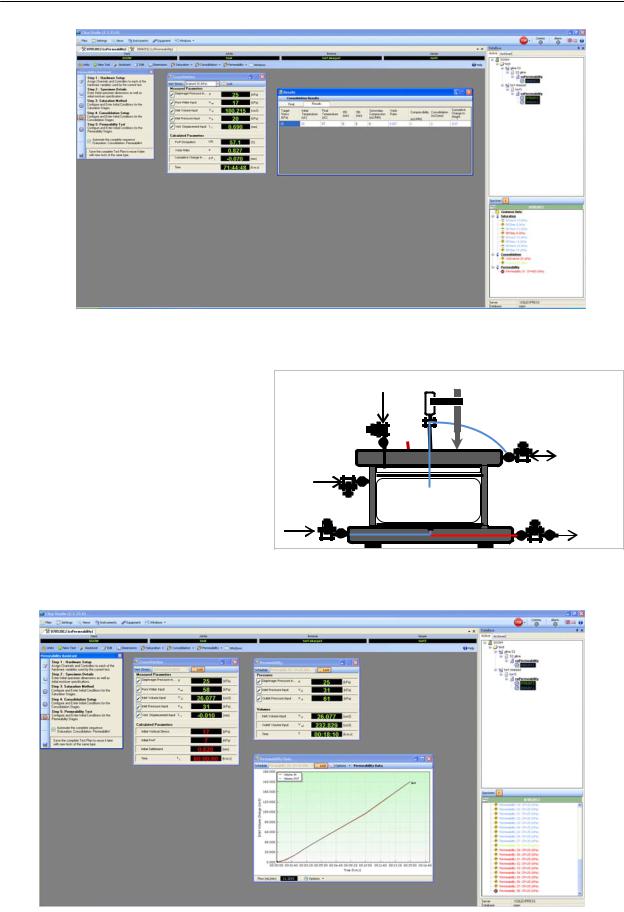
Раздел 4. Лабораторные и полевые исследования грунтов и фундаментных конструкций…
Fig. 5. – The consolidation test set up
Fig. 6. – The Modified Row Cell set up for permeability tests:
L-loading/stress value, S-settlement sensor, A-air flow, BP-back pressure for holding effective pressure, BPhback pressure to set horizontal flow, BPvback pressure to set vertical flow, PWP-pore water pressure sensor
|
L |
|
S |
|
A |
BP(h) |
BP |
|
BP(V) |
PWP |
|
Fig. 7. – The permeability stages set up
237

Современные геотехнологии в строительстве и их научно-техническое сопровождение
THE MRCS SOFTWARE
The ClispStudio Program was created by VJ Technology Company to conduct, read, record, and analysed consolidation and permeability tests. This program can conduct consolidation tests with increasing load (IL) or constant rate of strain (CRS). To apply CRS test, the program has to regulate the pressure to get constant rate of strain. For that reason, it is necessary to communicate with the hydraulic device controllers (HDC) and to get the informations by miniscanner connected with PC.
All data tests are directly send to the csRowe program. The opportunity to view them in one window, makes it easy to monitoring, controlling and correcting parameters during the test.
It is possible to plot the graphs in linear and non-linear time scale. Also, the schemes are available to be drawing in different relations, during the test.
The ClispStudio Program is supplied in safe system controller, that stops the test above some high values. All data test, can be explored to conventional data format, as excel. The only disadvantage of this program is its difficulty.
SOME CONSOLIDATION AND FLOW CHARACTERISTICS IN SOFT ORGANIC SOILS OBTAINED FOROM MRCS
The consolidation and flow parameters were obtained from laboratory tests on soft organic soils taken from Campus SGGW test site, with physical parameters as showed in Table 1.
The consolidation parameters were performance in “free strain loading” conditions [10] with different effective stress value; for 5kPa, 25kPa, 50kPa and 100kPa. Only some of the test results are presented in this paper (Fig.8.- Fig. 10).
Table 1
Physical properties of peats taken from „Campus SGGW” tested area
|
Physical properties |
|
„Campus |
||
|
|
|
|
SGGW” |
|
|
Water content wn [%] |
|
|
385 |
|
|
Density of solid particles s |
|
15 |
|
|
|
[kN/m3] |
|
|
|
|
|
Bulk density [kN/m3] |
|
10–12 |
|
|
|
Dry density d[kN/m3] |
|
2.5 |
|
|
|
Organic matter content Iom [%] |
|
|
78 |
|
|
Humification degree R [%] |
|
65 |
|
|
|
Porosity n [-] |
|
|
0.8 |
|
|
Initial void ratio e0 [-] |
|
4.0 |
|
|
238

Раздел 4. Лабораторные и полевые исследования грунтов и фундаментных конструкций…
Fig. 8. – The consolidation curve for effective vertical, one-direction way stress equal 5kPa
Fig. 9. – The stress – strain characteristic for effective vertical, one-direction way stress equal 5kPa
239
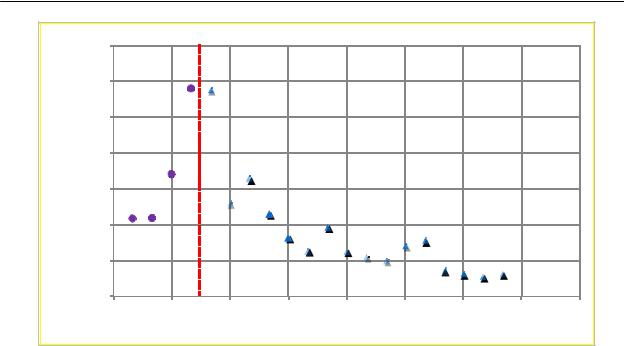
Современные геотехнологии в строительстве и их научно-техническое сопровождение
prelineary |
postlineary |
phase |
phase |
V [m/s]
i [-]
Fig. 10. – The relationship between flow velocity and hydraulic gradient in prelineary and poslineary phase for effective vertical, one-direction way stress equal 5kPa
DISCUSSION OF THE RESULTS
Large values of deformation and a non-linear character of strain and permeability are obvious in soft organic soils under loading. Therefore, the prediction of consolidation performance in organic subsoil should be carried out by methods which take into account the variation of soil parameters and large strains analysis. The flow-pump technique used to obtain flow characteristics in soft organic peats is perfect because of the small values of hydraulic gradient that can be applied [4].
In the Modified Rowe Cell Set is adapted to measure, at the same time, the consolidation and permeability parameters in two directions; upwards and downwards, and two radial direction; inwards and outwards. The test results are similar to those obtained in flow-pump technique tests.
In this paper, also it has been showed that to describe the flow characteristics the prelineary and postlineary phases should be considered. The non-linear prelineary phase characterizes flow at very low hydraulic gradient which usually appears in situ. In high values of hydraulic gradient the non-linear postlineary phase appears, which can be only possible with the hydraulic penetrate [4, 7].
Because of very week organic soils structure and specific properties, such as, high porosity, low shear strength and high initial permeability which decrease during consolidation and two flow phases the optimized method for flow measurement in peats is flow-pump technique, but used with MRCS to obtain also different directions of permeability for better description of flow characteristics.
240
